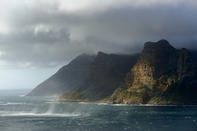A Stormy Tale
In days of old many Europeans "weak of lung" were sent to the Cape to recuperate. The first Portuguese who spied Table Mountain and rounded the fabled Cape in the 1480s named it Cabo da Tormentosa - the Cape of Torment, or Storms.

The legend of the Flying Dutchman tells the story of Dutch Captain Van Der Dencken who, try, try and try again as he might, to punch through a juggernaut southeaster to round Cape Point. He ended up cursing God for his poor fortune. The Lord returned the favour and now the captain spends eternity in that pursuit.
The strangest thing about this story, though, is how many people, from ship's pilots to royalty, have claimed seeing the fated ship playing the wind-whipped spray. Later, in an attempt to lure people here, the royal cartographers in the court of Prince Henry of Portugal hanged Tormentosa to Bona Esperanca - Good Hope - and so it has remained down the ages through fair wind or foul.
Even way back when mail was left in smelly old sailors' boots tied in tree branches at well-used anchorages, the Cape was the subject of many a stormy tale. So much so, that when Francis Drake - later Sir, dropped anchor in Table Bay on his circumnavigation back in 1578, he declared in his log that it was, contrary to its reputation as the most dangerous cape in the world, "a most stately thing and the fairest cape we saw in the whole circumference of the earth." It depended, then as now, on which way the wind blows.
By David Fleminger It is the famous South-Easter wind that causes the ‘tablecloth’ of clouds over Table Mountain. During summer, this prevailing wind howls...
It is the famous South-Easter wind that causes the ‘tablecloth’ of clouds over Table Mountain. During summer, this prevailing wind howls...